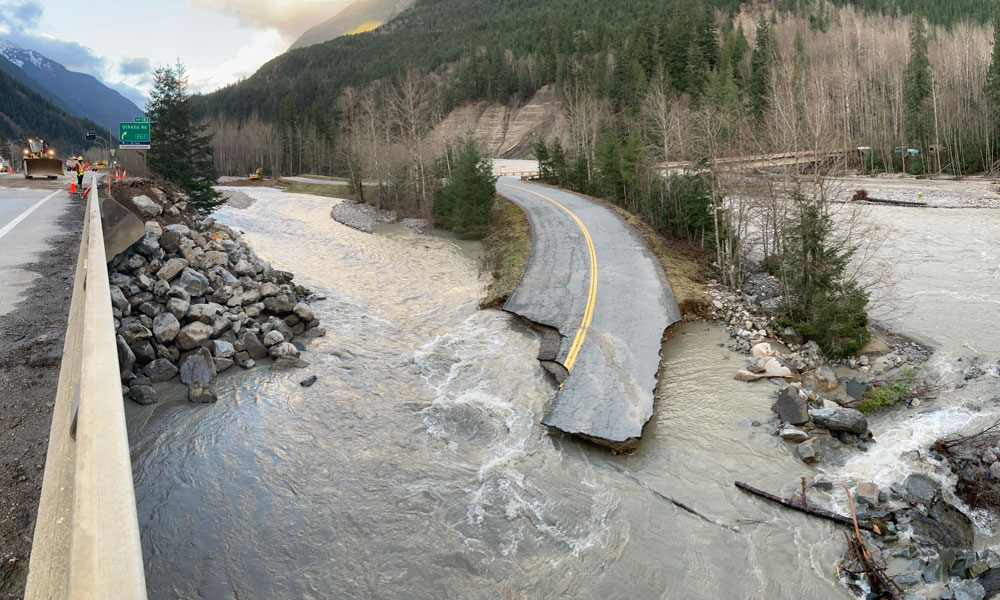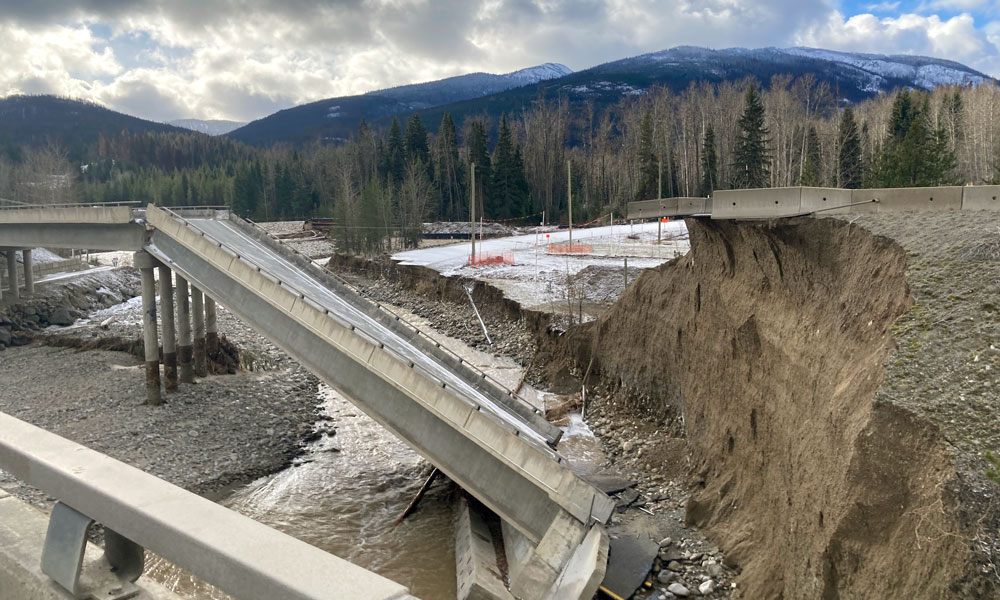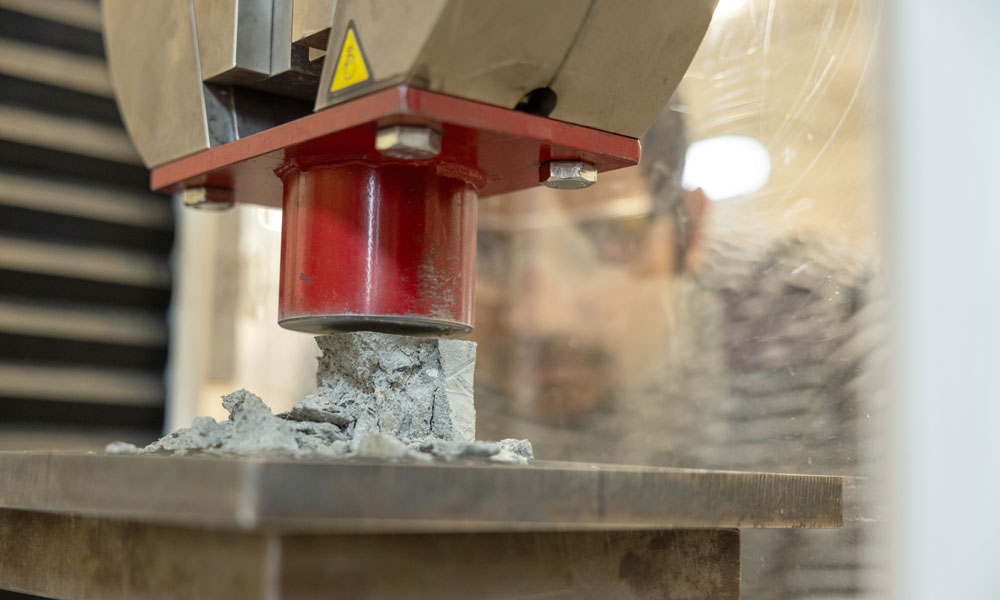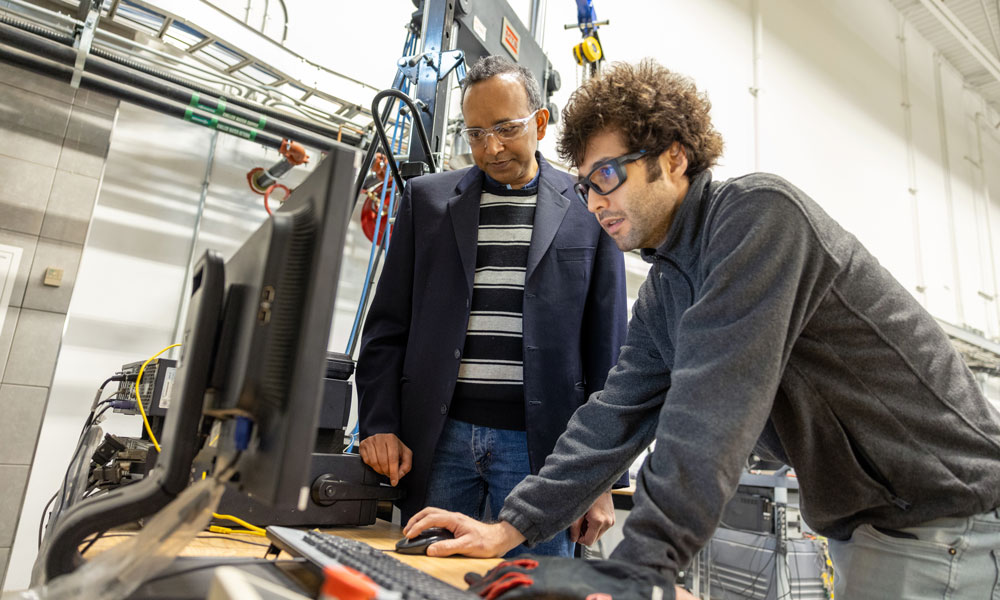
Dr. Shahria Alam (left) and Dr. Sherif Osman examine the crack propagation of a damaged concrete bridge pier following a simulated earthquake load. An example of sustainable engineering in action, the concrete bridge pier is reinforced with stainless steel rebars, which is expected to increase the corrosion resistance and service life of bridges.
Stretching 543 kilometres from Hope to Kamloops, BC, the Coquihalla Highway is a vital corridor linking Canada’s west coast with the rest of the country. However, in November 2021, unprecedented flooding washed out more than 20 sites along 130 km of highway, including seven bridges.
The shortest and most critical link between the BC interior and the coast was severed for weeks, negatively affecting supply chains and ultimately costing the government more than $1 billion in repairs.
“What happened to the Coquihalla Highway was a perfect example of how unprepared Canada is in response to climate change hazards,” says Dr. Shahria Alam, a Professor of Civil Engineering at UBC Okanagan.

The Othello Interchange on BC Highway 5 after an atmospheric river blew through on November 14, 2021. Photo courtesy of BC Ministry of Transportation and Infrastructure.

A bridge located at Juliet, 53 kilometres south of Merritt, collapsed and has since been rebuilt to be more climate-resilient. Photo courtesy of BC Ministry of Transportation and Infrastructure.
“We’ve designed our structures to bear loads based on historic data, but with climate change, everything is different. We’re dealing with unknown hazards and unknown natural load combinations, so as researchers, we must find a statistical balance of how the future might play out.”
In Dr. Alam’s Applied Laboratory for Advanced Materials and Structures (ALAMS), his team of undergraduate and graduate students is doing just that: exploring advanced materials through extensive applied experimental work.
By subjecting ultra-high-performance concrete and high-strength/superelastic reinforcements to various tests simulating potential real-world conditions, Dr. Alam aims to build modern resilient structures with lifespans upwards of 200 years.

Meraj Rubayat Kamal and Rubaiya Rumman, engineering doctoral students at ALAMS, check the final calculations for a measurement of mortar mixes.
Sustainably retrofitting for climate resilience
Catastrophic events like what happened on the Coquihalla Highway only stand to increase as climate change conflicts with vulnerable road structures and higher traffic volumes.
The result is incredible pressure on Canada’s aging roads and bridges—further exacerbated in BC by the ever-present threat of earthquakes along the west coast’s Cascadia Subduction Zone.
“Retrofitting existing infrastructure will help protect it against future disasters, but we have to explore more sustainable ways of doing that by considering life cycle costs,” Dr. Alam explains. “At the same time, we have the opportunity to use different—and more advanced materials—to make our structures more resilient.”
Some unique alternative materials being explored in Dr. Alam’s lab include the combination of wood fly ash—a byproduct of burning sawdust—and cement to produce green concrete. Wood fly ash has been found to have great potential as a substitute for coal fly ash, a green cement supplement that is becoming obsolete as coal power plants shut down around the globe.
His research team is also exploring the use of advanced materials like super elastic Nitinol bars, fibre-reinforced plastic bars and high-strength-steel reinforcing bars; the incorporation of green concrete developed from industrial waste and substances like demolished concrete from old buildings and bridges; and recycled rubber from old tires.
Many of Dr. Alam’s projects are collaborations with other professors in the School of Engineering, enabling him to broaden the scope and influence of his research.
“UBC Okanagan attracts top talent from around the world, and when they join my research group, they enrich our work with diverse insights and expertise. I believe this is key to opening doors to the kinds of innovative projects and perspectives we’re working on.”
He adds: “Everyone in my lab has a similar motive; we don’t want to just study about sustainable construction and then publish our findings in a journal. We want to create the most change possible in the real world.”
Climate-proofing BC’s highways and bridges
Considering the climate change and seismic challenges facing sections of BC’s roads, Dr. Alam and his team have partnered with the BC Ministry of Transportation and Infrastructure and various private companies to help address the province’s urgent needs.
“British Columbia has more than 2,500 highway bridges; many are old and require different retrofitting schemes.
“Given the funding available, how do we prioritize which bridges are retrofitted and the level of functionality you want the bridge to have?”
In a previous project, Dr. Alam assisted the ministry in expanding its knowledge about the current condition of the province’s bridges—documenting everything from construction materials and bridge length to foundation type, structural health rating, and construction period.

Meraj Rubayat Kamal, a civil engineering doctoral student at ALAMS, tests the compressive strength of mortar cubes made of wood fly ash.

The cubes are tested after 28 days of curing under standard curing conditions.
“This comprehensive information is crucial for proper infrastructure management and rehabilitation in an increasingly climate-prone world,” Dr. Alam says.
Furthering this provincial work, Dr. Alam and industry partners are now developing a way to identify and prioritize bridges in BC that need to be evaluated for seismic retrofitting following lifecycle costs.
A second aspect of the study aims to introduce innovative cost-effective bridge retrofit and repair measures using any of the high-strength or sustainable advanced materials currently being tested in Dr. Alam’s lab.
“Take the example of high-strength steel reinforcing bars, which could have a lower carbon footprint than traditional steel. But we can’t use this material to its full potential in seismic zones because of design code restrictions, since there’s a lack of research,” Dr. Alam says.
His research team aims to assess and document the performance of high-strength steel reinforcing bars in bridge columns and, hopefully, develop recommendations on how to incorporate this material into future design codes.

Dr. Ahmad Rahmzadeh, a Postdoctoral Fellow at ALAMS, applies simulated earthquake loads to test the effectiveness of energy-dissipating devices. Such sustainable engineering devices can help reduce damage to buildings and bridges during an earthquake.
For Dr. Alam, this kind of applied research work is vital; by addressing local problems, his work has global influence. He is already collaborating with numerous institutions, including Abu Dhabi University, UAE University, Nagoya Institute of Technology and Tongji University in separate sustainable engineering projects.
“The legacy of the Coquihalla Highway disaster is that it illustrated how infrastructure resiliency affects day-to-day life, emergency response and economic development in a region.
“My team is working on developing and testing alternative materials to see if they can be valuable to various industries or community partners—and if they can serve the greater good, then why shouldn’t we explore this?” Dr. Alam asks.
“Most countries are working toward the common goal of tackling climate change, so if there is anything the team and I can do to resonate with the wider world and create solutions, we’re going to try.”




